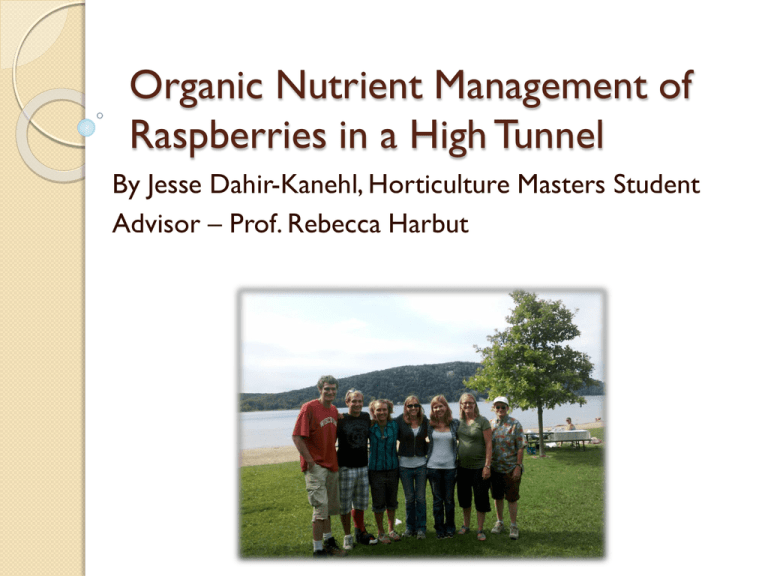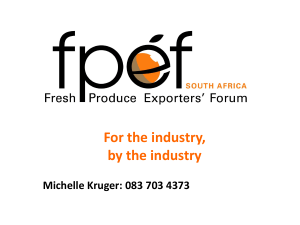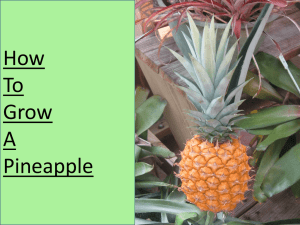Organic Nutrient Management 3
advertisement

Organic Nutrient Management of Raspberries in a High Tunnel By Jesse Dahir-Kanehl, Horticulture Masters Student Advisor – Prof. Rebecca Harbut Quick Research Intro Effects of high tunnel environment on microbes and mineralization of N, P, K Mineralization differences seen in plant tissue, yields, and berry size? Lack of leaching > higher salt buildup Increase in fruit quality Decreases in wind leading to taller plants Decrease in pest pressure (Japanese Beetle) and change in pest complex Decrease in disease pressure Background High School FFA Greenhouse Bachelors at UW-Madison, Horticulture Organic Vegetable and Fruit Farm Hobbies: brewing, gardening, biking, folk Coops: Babcock House Overview 1. High Tunnel (HT) Production a. Definition b. Why? c. Disadvantages d. Uses in Wisconsin e. Research being done with HTs 2. Organic Fruit Production in Wisconsin a. Problems b. Organic fruit farm/orchard management c. Why? d. Research being done 3. My Research Project – No data a. What’s being studied b. Where c. When d. Why e. Results f. Spreading the word High Tunnel Production Temporary season extending structure Arched roof & high sides – snow shedding Great for tall crops or large machinery Relatively new tool, but why use it? Why? Higher temps > higher mineralization Extends season Exclusion of rain – target irrigation Reduce application rates Increases fruit quality Reduces disease and pest pressure Changes pest complex Reduces wind, increases height Marketing Temperature Primocane-fruiting Raspberry Production in High Tunnels in a Cold Region of the Upper Midwestern United States (Yao and Rosen, 2011) Plant Height Average (in) HT 08 Field 08 HT 09 Field 09 64 25 62 28 High Tunnel Avg. - 2009 Field Avg. - 2009 Fruit Size Yield Fruit Size Yield 4.0g 22,253 lb/a 3.8g 4,708 lb/a Disadvantages Relatively expensive Requires high return Salt buildup Use in WI Stephen McDonough, NCSU, 2008 How are they used in Wisconsin? Mostly season extension Largely vegetables – tomatoes Nurseries Some fruits - raspberries & strawberries National Resources Conservation Service program – 2010, 184 tunnels, $763k NRCS, 2009 Research on HT Small Fruit Production in HT, Demchak, 2009, Penn State HT Tree Fruit Production, Lang, 2009, Michigan State CO2 Enrichment May Increase Yield of Field-grown Red Raspberry under HT, Mochizuki et al., 2010, U of California and California State Engineering Principles Impacting HT Environements, Giacomelli, 2009, University of Arizona Trends in Soil Quality Under HTs, Knewston et al., 2010, Kansas State University Yields and Economics of HTs for Production of Warm-season Vegetable Crops, Waterer, 2003, University of Saskatchewan HT and Organic Horticulture: Compost, Food, Safety, and Crop Quality, Milner et al., 2009, USDA Maryland + University of Georgia, Cornell, Colorado State, University of Minnesota, University of Arkansas University of Arkansas, 2011 Overview 1. High Tunnel (HT) Production a. Definition b. Why? c. Disadvantages d. Uses in Wisconsin e. Research being done with HTs 2. Organic Fruit Production in Wisconsin a. Problems b. Organic fruit farm/orchard management c. Why? d. Research being done 3. My Research Project – No data a. What’s being studied b. Where c. When d. Why e. Results f. Spreading the word Problems in WI Maintaining high soil quality Hot + humid = disease Pests Perennial system means perennial weeds Overcoming common beliefs of perfection Pestmall, 2010 Organic Management Soil amendments Pest control Disease control Weed control Marketing – processing Beverage Express, 2011 High Tunnel Tree Fruit Production: The Final Frontier? (Lang, 2009) Pest Increased Incidence Decreased Incidence Diseases Powdery Mildew Cherry Leaf Spot Bacterial Canker Insects Black Cherry Aphid Plum curculio Two-spotted Spider Mite Cherry Fruit Fly Japanese Beetle Why? Price premium Marketing Sustainability Personal beliefs Golden State Fruit, 2012 Research Pest control Weed control Soil amendments Increase density Season extension Breeding Postharvest Nutrition Sustainability – economic & environmental Overview 1. High Tunnel (HT) Production a. Definition b. Why? c. Disadvantages d. Uses in Wisconsin e. Research being done with HTs 2. Organic Fruit Production in Wisconsin a. Problems b. Organic fruit farm/orchard management c. Why? d. Research being done 3. My Research Project – No data a. What’s being studied b. Where c. When d. Why e. Results f. Spreading the word My Research Organic fertilizers – cow manure, mushroom, fish emulsion, urea, none Varieties – Caroline & Heritage Mineralization Electrical Conductivity Yield Hatch and Sustainable Agriculture Research and Education grants Where West Madison Research Station Plano silt loam & Kegonsa silt loam HT and outside – 96’ x 30’ Cole Murphy – Fond du lac Peninsular Research Station When 2011 – establishment year 2012 – soil data, yields, etc 2013 – soil data Why? Fertilization recommendations for HT Application times Understanding of HT environment For the grower 100 Mile Challenge Spreading the word Midwest Organic and Sustainable Education Service conference Publish in a journal Center for Integrated Agriculture Systems Talk to professors, extension agents, producers Other conferences Conclusion HT ◦ ◦ ◦ ◦ Cost Yield, season, quality Pest pressure Reliability and control Organic Fruit ◦ Price premium ◦ Difficulties ◦ Inputs Research ◦ Fertilizer recommendation Further Research Adapting HT to tall fruit crops or vice versa Other crops? – borderline hardy plants Yield modeling inside HT environment Effects of dry walkways on soil Further studies into HT multiple effects on soil microbes and biology Questions and Comments Kathy Kitchens Downie, 2012







